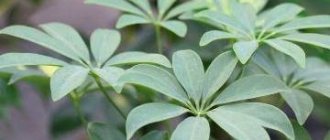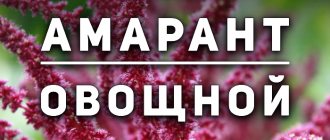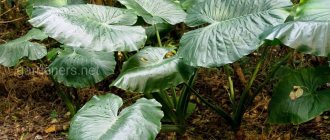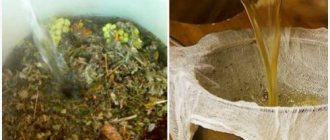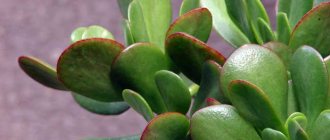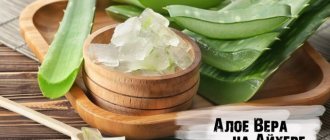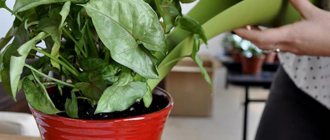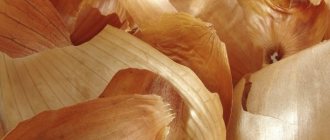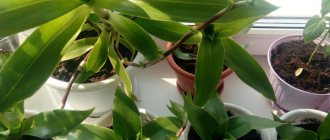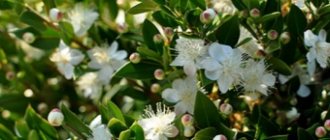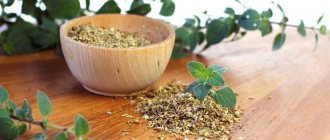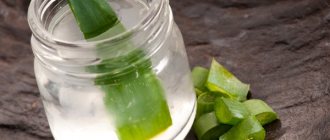Somewhere in East Asia, a plant called Alocasia appeared in the tropical forests. You can find this flower in Malaysia and Ceylon growing in the wild.
Author of the article
Eduard Dmitriev
Florist and lover of indoor and garden plants.
What types are medicinal?
Only one variety of alocasia, called Alokasia macrorhiza, is medicinal. – large rhizomatous. It contains the lowest concentration of toxic substances, and its roots are even eaten in some countries. This plant is recognized by its tuberous root, similar to the fleshy ginseng tuber. The healing properties of large-rooted alocasia are not inferior to such well-known medicinal plants as golden mustache, eucalyptus and calamus root.
It is important to know
Of all the varieties of alocasia, only one type is used for medicinal purposes, the large-rooted one. The juice from the plant cannot be used in its pure form.
Alocasia is a poisonous plant. It contains hydrocyanic acid. You should be extremely careful when working with it. It is better to harvest the plant while wearing rubber gloves, avoiding contact with the skin. If there are animals or small children in the house, it is advisable to protect their access to the plant.
Video: Large-rooted Alocasia
Chemical composition
In the official lists of medicinal plants, alocasia is listed only in some countries, where it is found in nature, and in general its chemical composition has not been sufficiently studied. It is known that all parts of this plant contain toxic substances - sublimate, mercury and hydrocyanic acid.
The healing properties of alocasia are due to the content of a number of biologically active substances in it, such as:
- flavonoids (quercetin, hyperoside, lycuroside);
- coumarins;
- alkaloids, one of which resembles quinine in composition.
It also contains:
- saponins;
- cardiac glycosides;
- tannins and anthracene derivatives.
General information
The description of the flower includes many varieties and hybrids, but the main one grown as a houseplant is “Polly” or “Amazon” (A. amazonica).
Photos of Alocasia are impressive with stunning leaves that are shaped like an arrowhead or shield with large prominent white veins running through them, which contrasts greatly with the rest of the dark green leaf.
What effect does the flower have?
Scientists have found that in addition to potent poisons, the plant contains many biologically active substances that have powerful anti-inflammatory, antimicrobial and expectorant effects . In addition, alocasia juice affects the immune system and the human body as a whole, activating its defenses and stimulating the functioning of the hormonal system.
In folk medicine, alocasia is used to treat:
- diseases of the musculoskeletal system - arthritis, rheumatism, myositis, osteochondrosis, herniated disc, gout, osteoarthritis, etc.;
- skin diseases - psoriasis, rashes of various origins, including allergic origin;
- varicose veins and thrombophlebitis;
- fibroids, fibromas and other benign neoplasms;
- tuberculosis;
- malignant tumors.
Is the plant poisonous?
The plant is toxic to people and pets due to calcium oxalate crystals contained in its sap. However, this is more of a defense mechanism, and consumption of the plant tends to have unpleasant side effects and is rarely fatal.
Contraindications, possible harm
Kidney disease, liver disease and hemophilia require complete cessation of the oral use of alocasia-based products. The plant should not be used as a medicine even with minor manifestations of allergies. The use of alocasia preparations by children, as well as pregnant and lactating women, is not allowed.
Before taking Alocasia medicine internally, you should consult your doctor .
If during treatment there are side effects similar to signs of poisoning - weakness, vomiting, dizziness, upset stomach - you should immediately stop taking the drug and seek medical help.
Use of alocasia preparations for stomach ulcers
Alocasia indica was studied in 2011 in the city of Krishna, where its positive effect on the gastrointestinal tract was confirmed. Diarrhea stopped, and the composition showed antiprozoal properties, that is, the destruction of pathogens. Taking the tincture reduces pain in the stomach due to peptic ulcers. But the research was not documented. The use of alocasia for the treatment of stomach ulcers has not yet been confirmed by medical research. Healers use the tincture for treatment. For those whose ulcers are in remission, traditional healers advise in the spring and autumn to carry out a course of treatment with alocasia for stomach ulcers. However, healers advise consulting with your doctor before taking the tincture. But if there is concomitant heart disease, then alocasia should be abandoned.
Taking the dose prescribed by the healer will not only help not to worsen the disease, but alocasia will also provide prevention against cancer. To obtain the composition, mix one spoonful of crushed alocasia mass with a glass of honey and a bottle of vodka. Shake until the honey dissolves and leave in a dark place for 10 days. Shake before use. Drink a tablespoon 3 times a day half an hour before meals. After 2 weeks, repeat everything in the same proportion. The preparation of a portion for one course is described.
Traditional medicine is not a panacea. Only together with specialists who have active drugs at their disposal, herbalists can provide a gentle effect on the body of a green pharmacy. But they do not know about concomitant diseases, without taking them into account, they can cause harm, rather than benefit, to health. Therefore, joint treatment will be correct and effective.
Field of application in medicine
Despite the content of toxic substances in its composition, and perhaps because of them, Alocasia large-rooted (Arma) has traditionally been used in Chinese medicine to treat cancer . The anticancer potential of arma, or rather its water infusion, was carefully studied at the University of Sichuan Province, where it was confirmed that it inhibits the growth of hepatoma.
Along with this, the Russian All-Union Scientific Research Institute of Medicinal Plants discovered the analgesic effect of 40% alcohol tincture of alocasia, obtained when applied externally in the treatment of osteochondrosis, myositis, pain in the joints and restoration of their mobility.
Amazingly, this highly poisonous plant has also been recommended for the treatment of miasmatic poisoning.
It should be noted that in the traditional medicine of our country, the properties of alocasia have not found much use. Using medicinal products from the plant without proper knowledge can be life-threatening . Therefore, information about the benefits of the plant is given not as a guide to action, but as information about the greatness and capabilities of nature.
The medicinal properties of arma can be used in precise dosage, under the guidance of a specialist and with the approval of the attending physician. Products for external use must be pre-tested by trial application to a small area of skin. An experienced healer selects the dose of alocasia for the treatment of a particular person individually.
Alocasia: home care, medicinal properties
Before moving on to the question of caring for Alocasia, it should be said once again that plants of this species were brought from a tropical climate; this is precisely what is associated with the features that must be taken into account in order to maintain the healthy state of the flower.
- Lighting. Bright light is necessary for every type of Alocasia. However, it should not be straight, as this may damage the plant. It shouldn't be too dark. It is best to place the plant near the eastern or western part of the room. It is there that the listed requirements will be combined as much as possible.
- Humidity. The tropics are characterized by high humidity, and plants grown at home also need it. It is recommended to spray Alocasia with water. This water must be warm and settled, otherwise it can lead to plant disease. In summer, spraying is necessary often, but in winter you need to know when to stop. Excessive humidity combined with low temperature is the cause of plant disease.
- Temperature. For the normal development and growth of Alocasia, it is necessary to maintain a certain temperature in the room. In summer it should not fall below 22 degrees or exceed 28, and in winter it should not be colder than 18 degrees.
- Watering, it is necessary to provide abundant watering. But this point must be fulfilled with a small reservation. Alocasia should be watered frequently only in summer, the optimal frequency is three to four times a week. In winter, this amount must be reduced.
- Fertilizing, do not forget about them, as well as about the correct soil. The soil must be breathable. Sand, peat, humus, and charcoal are perfect.
Folk remedies and methods of treatment
Tincture
To prepare it, you need one of the lowest leaves of alocasia along with the petiole.
- It is crushed.
- Pour in 500 ml of 40% alcohol.
- Leave to infuse in a dark place for 2-3 weeks.
The finished tincture is filtered and used for external and internal use. internally to treat fibroids, tuberculosis, various neoplasms and joint diseases .
- Use the tincture starting with 2 drops per 1 tablespoon of water 2 times a day 20-30 minutes before meals.
- Add 1 drop of tincture daily, increasing the amount of water accordingly. When reaching 15 drops, the amount of water should be 1/4 cup.
- Gradually, the volume of the medicine is increased to 25 drops at a time.
- Then they also begin to reduce the dosage, 1 drop per day.
After completing the course of therapy, you need to take a break for 2-3 months, and then repeat the course from the beginning. For the treatment of severe diseases and malignant neoplasms, it is recommended to take at least 3-4 courses.
Attention! Do not exceed the dose! The plant is poisonous!
For external use, alcohol tincture is needed:
- Dilute with water in a 1:1 ratio.
- Apply a cotton napkin soaked in this composition to the sore joint or areas of skin disease for 30-40 minutes.
- Repeat the procedure for 7-10 days.
To treat varicose veins, apply a compress daily before bed for 2-3 months in a row.
Also, alcohol tincture of alocasia can be used to relieve itching from insect bites.
Water infusion
- Carefully cut and chop the bottom leaf of the alocasia.
- Pour a glass of boiled water at a temperature of 80-90 ºС.
- Leave for 8 hours in a cool place.
Store in the refrigerator for no more than 2 days. This infusion is used for rinsing, compresses and lotions .
Leaf pulp
The bottom leaf of the trefoil is ground in a meat grinder to a mushy state. The resulting pulp is applied to sore spots for joint pain . To treat skin diseases, the leaf is crushed with a knife so that a minimum of juice is released.
Oil
- Chop the leaf along with the stem.
- Pour 5 tablespoons of warm linseed or olive oil into a dark glass bowl.
- Keep in the refrigerator for 2 weeks.
- Filter thoroughly and pour into the same container.
The resulting oil is good for 3 months. The product is used for rubbing into the skin or as compresses for joint and rheumatic pain .
Ointment
- Take 3 parts of fatty cream or fat.
- Add 1 part of large-rooted alocasia juice.
- To stir thoroughly.
Store the product in the refrigerator for up to 1 week. The ointment is used to treat joint diseases and trophic ulcers .
Hood
- Grind the bottom leaf and stem of the alocasia.
- Pour a bottle of vodka and close tightly.
- Infuse for 2 weeks at room temperature in a dark place.
The extract is used in the form of compresses:
- To the area of the thyroid gland. The product is applied to gauze folded in four and the compress is kept for about three hours. The procedure is carried out daily for 2 weeks. After a four-day break, the course can be repeated.
- For the treatment of fibrocystic mastopathy, the same compress is kept for up to 6 hours. After 3 procedures, the pain disappears, the tumor breaks up into smaller fractions, which then resolve.
- To treat thrombophlebitis, a compress from the extract is applied to the affected veins and left overnight. The procedure is repeated for 7 days, then a break is taken for 3 days, and a weekly treatment is carried out again. After a month, the course can be repeated.
Root
Alocasia rhizome is crushed and applied to tumors of various origins .
Treatment
Rheumatoid arthritis
- Finely chop the lower leaf of the plant along with the stem.
- Pour 100 ml of 96% alcohol.
- Infuse for 10 days.
Rub the resulting tincture on sore areas at night.
Liver cirrhosis
- Finely chop the leaf along with the petiole (about 100 g).
- Pour a bottle of vodka.
- Stir and place in a warm place for 7-10 days.
- Keep the finished composition tightly sealed in a dark place at room temperature. Do not remove raw materials.
The treatment is long-term. Dilute 1 tablespoon of tincture in 100 ml of water and drink in the morning on an empty stomach half an hour before meals.
Joints
- Take ficus and alocasia leaves in equal parts (1:1) and make a paste out of them.
- Combine 4 parts of the resulting mixture with 6 parts of internal fat.
- Keep refrigerated.
Use for polyarthritis, rheumatism, rub into joints. For severe pain, baths of alocasia leaves (2 leaves per 2 liters of boiling water) will help, leave for an hour, dilute with water 1:8.
Sore feet
Rubbing with an alcohol tincture from a fresh plant helps a lot (1 leaf for half a liter of alcohol). The product is also indicated for the treatment of rheumatism, radiculitis, has a resolving effect on bruises and is an excellent wound healer.
Asthma
- Pour 50 g of dry crushed alocasia leaves into a bottle of vodka.
- Infuse in a dark place, shaking the contents periodically.
- After three weeks, strain the tincture.
Severe forms of bronchial asthma are treated by taking 1 tablespoon of tincture daily with water. Take 2-3 times a day before meals. As an additional remedy, it is recommended to drink a decoction of raspberry leaves instead of tea. The course of treatment is no more than 15-20 days.
It has also been noted that products made from the leaves and stems of alocasia are effective against pneumonia and tuberculosis .
Antitumor medicinal properties of alocasia
In Russia, scientific research has been and is being carried out to study external treatment with alocasia tincture or an ointment prepared on its basis. The results are positive. The Buryat herbalist Badmaev also confirms the positive medicinal effect of the tincture.
In 2012, the antitumor medicinal properties of alocasia on hepatocellular carcinoma were studied in China, where it was finally established that alocasia large-root kills cancer cells in the liver. Official medicine has recognized this drug as useful specifically for the treatment of liver cancer.
The drug is taken under the strict supervision of doctors. Suffice it to say, treatment begins with one drop of tincture diluted in a tablespoon of water, and increases every day by only one drop, and then decreases in the same order. The two-month course can be repeated only after a long break. The scheme was developed and applied by healer L. Kim.
The whims of a tropical woman
This lady belongs to the decorative leaf group.
Growing a green friend in an apartment garden is not difficult if you remember a few rules.
Take care of it, observing safety precautions, keep it away from animals and children.
She loves bright, diffused light, and it is recommended to place the flowerpot on east and west windows. It is also possible to place it on the south side, only with shading.
The beauty's homeland is the tropics. The high humidity of the forests of Ceylon, China and Malaysia creates an ideal habitat for the greenhouse miracle.
But in a temperate climate it is not easy to create suitable conditions for it. But probably. In the hot season, favorable conditions for it are at an air temperature of 24-26 degrees. In cold weather, during the rest period, 15-18 above zero is enough.
Spray only with warm water, otherwise unsightly spots will appear. In the cold season, do not spray, but wipe the leaves with a dampened sponge.
Also, for the desired microclimate, place a pot with capricious plants in a container with pebbles, which will contain water. On particularly hot days, it is recommended to put a few pieces of ice on the pebbles.
Variety of colors
There are more than 70 varieties of elephant ear in the wild. But there are several options available for florists.
Polly. Sandera's miniature double. Popular due to its unusual combination of rich grassy color and white veins. A small bush 50-65 cm high. It is also called “African mask”.
Amazonian (Amazonica). A hybrid variety resulting from crossing. Dark “palms” with light veins and zigzag edges form a compact bush measuring 40-60 cm.
Black velvet or Black Velvet. Juicy velvety burdocks are almost black in color. But the back side of the leaf is smooth and green. Low, only 30-45 cm.
Kalidora. The fragrant variety has retained its original appearance and color. It grows up to two meters and its smell resembles the aroma of a lily.
Large-rooted, Indian or Armagh. Its peculiarity is that it calmly tolerates the lack of water and temperature changes. In the native East it reaches 5 meters, in greenhouses 1.5-2.
Sandera. Same size as Polly. The second name "Chris" was given due to the leaf's resemblance to an Asian knife with a jagged edge.
Optimal time for planting
Alocasia should be planted in permanent soil immediately after purchasing it in a store.
You need to plant alocasia in a pot like this:
- The roots of the plant must be cleaned of soil and carefully inspected, identifying those that are dried out and rotten. The latter need to be removed.
- Alocasia roots need to be washed from the substrate and soaked for half an hour in a nutrient solution to improve the adaptive process of the plant.
- Now the flower needs to be placed in a previously prepared pot and filled with new soil. The root collar remains half-open, located at the very border of the soil.
The ideal time for planting alocasia is considered to be spring, when the plant enters the active growth phase. During the summer, the plant will have time to settle into its new location and will survive the winter well. However, if the plant was purchased in the autumn-winter period, it can and should also be planted in a pot. Only the adaptive period in this case takes a little longer.
